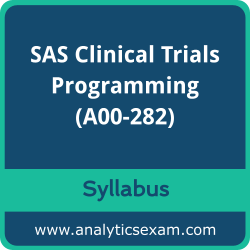 Welcome to your one-stop solution for all the information you need to excel in the Clinical Trials Programming Using SAS 9.4 (A00-282) Certification exam. This page provides an in-depth overview of the SAS A00-282 Exam Summary, Syllabus Topics, and Sample Questions, designed to lay the foundation for your exam preparation. We aim to help you achieve your SAS Certified Professional - Clinical Trials Programming Using SAS 9.4 certification goals seamlessly. Our detailed syllabus outlines each topic covered in the exam, ensuring you focus on the areas that matter most. With our sample questions and practice exams, you can gauge your readiness and boost your confidence to take on the SAS Clinical Trials Programming exam.
Welcome to your one-stop solution for all the information you need to excel in the Clinical Trials Programming Using SAS 9.4 (A00-282) Certification exam. This page provides an in-depth overview of the SAS A00-282 Exam Summary, Syllabus Topics, and Sample Questions, designed to lay the foundation for your exam preparation. We aim to help you achieve your SAS Certified Professional - Clinical Trials Programming Using SAS 9.4 certification goals seamlessly. Our detailed syllabus outlines each topic covered in the exam, ensuring you focus on the areas that matter most. With our sample questions and practice exams, you can gauge your readiness and boost your confidence to take on the SAS Clinical Trials Programming exam.
Why SAS Clinical Trials Programming Certification Matters
The SAS A00-282 exam is globally recognized for validating your knowledge and skills. With the SAS Certified Professional - Clinical Trials Programming Using SAS 9.4 credential, you stand out in a competitive job market and demonstrate your expertise to make significant contributions within your organization. The Clinical Trials Programming Using SAS 9.4 Certification exam will test your proficiency in the various syllabus topics.
SAS A00-282 Exam Summary:
| Exam Name | Clinical Trials Programming Using SAS 9.4 |
| Exam Code | A00-282 |
| Exam Duration | 110 minutes |
| Exam Questions | 60-70 |
| Passing Score | 68% |
| Exam Price | $180 (USD) |
| Books / Training |
SAS Programming 1: Essentials SAS Programming 2: Data Manipulation Techniques SAS Report Writing SAS SQL 1: Essentials SAS Macro Language 1: Essentials Statistics 1: Introduction to ANOVA, Regression, and Logistic Regression |
| Exam Registration | Pearson VUE |
| Sample Questions | SAS Clinical Trials Programming Professional Certification Sample Question |
| Practice Exam | SAS Clinical Trials Programming Professional Certification Practice Exam |
SAS A00-282 Exam Syllabus Topics:
| Objective | Details | Weight |
|---|---|---|
| Clinical Trials Process |
- Describe the clinical research process (phases, key roles, key organizations). - Derive programming requirements from an SAP and an annotated Case Report Form. |
5% |
| Clinical Trials Data Structures |
- Identify the clinical trials domains. - Identify key CDISC principals and terms. - Describe the structure and purpose of the CDISC SDTM data model. - Describe the structure and purpose of the CDISC ADaM data model. - Trace data through the full programming process, from raw data to any of the mapped domains. |
10% |
| Regulatory Submissions |
- Apply regulatory requirements to exported SAS data sets (SAS V5 requirements). - Describe the contents and purpose of define.xml. |
5% |
| Manage Clinical Trials Data |
- Access DICTIONARY Tables using the SQL procedure. - Examine and explore clinical trials input data (find outliers, missing vs. zero values).
|
5% |
| Transform or Summarize Clinical Trials Data |
- Derive variables by applying categorization and windowing techniques to existing variables. - Store dates in a form that is acceptable for use with clinical trials
- Reshape SAS data sets:
- Calculate 'change from baseline' results. |
15% |
| Apply Statistical Procedures for Clinical Trials |
- Use SAS procedures to obtain descriptive statistics for clinical trials data (FREQ, UNIVARIATE, MEANS, SUMMARY). - Given information on data types (categorical vs. quantitative), determine whether a procedure can produce the requested analysis. - Given sample code from a statistical procedure, identify syntax and/or semantic errors. (PROC FREQ, PROC TTEST, GLM, REG) - Create output data sets from statistical procedures.
- Follow instructions to be able to program for both Safety and Efficacy data. |
15% |
| Macro Programming for Clinical Trials |
- Create macro variables and set macro parameters. - Access user-defined and automatic variables. - Automate repeated tasks by defining and calling macros. - Use system options to debug macros and display values of macro variables in the SAS log (MPRINT, SYMBOLGEN, MLOGIC). |
15% |
| Report Clinical Trials Results |
- Use PROC REPORT to produce tables and listings for clinical trials reports.
- Use ODS statements to produce and augment clinical trials reports.
- Create and work with graphs
|
10% |
| Validate Clinical Trial Data Reporting |
- Explain the principles of programming validation in the clinical trial industry. - Utilize the log file to validate clinical trial data reporting. - Use programming techniques to validate clinical trial data reporting (PROC COMPARE, MSGLEVEL). - Determine why two independent validation programs led to a different result. - Identify elements that are not validated when comparing via PROC COMPARE. (titles, footnotes, and attributes such as formats or labels depending on how they are added to a PROC-like REPORT) - Identify and Resolve data, syntax, and logic errors. |
20% |
The SAS has created this credential to assess your knowledge and understanding in the specified areas through the A00-282 certification exam. The SAS Certified Professional - Clinical Trials Programming Using SAS 9.4 exam holds significant value in the market due to the brand reputation of SAS. We highly recommend thorough study and extensive practice to ensure you pass the Clinical Trials Programming Using SAS 9.4 exam with confidence.
